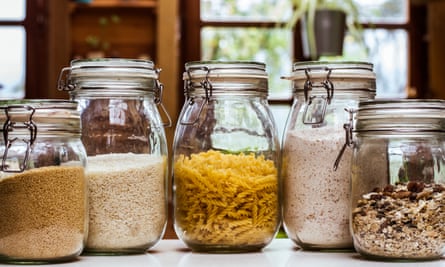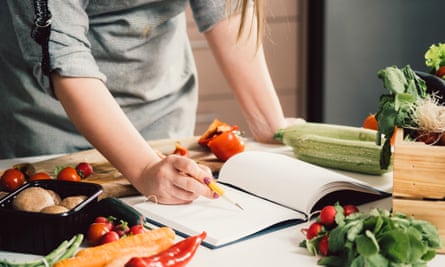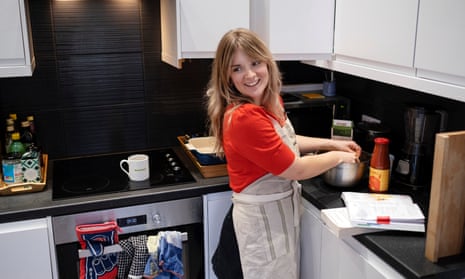For most of my life, I have been a terrible cook. Some people say they are terrible cooks then whip up a perfectly palatable meal for four. I have given myself food poisoning, twice.
My regular diet used to include microwaved scrambled eggs, children’s lunchbox cheeses, tinned lentils mixed with tinned tomatoes, bowls of garden peas, and the “complete food” powder Huel. I alternated between the same two dinners for nearly a year, and the same sad desk lunch for two years.
In short, I scavenged like a raccoon. I wrote cooking off as “not my thing” alongside, say, basketball. And I am not alone.
According to a 2014 YouGov survey of 10,000 Britons, one of the largest ever conducted about food, 10% of us cannot cook a thing – equating to 5 million people. A smaller survey in 2018 found that 25% of respondents could only make three dishes (including boiled egg and soldiers, and porridge).
I had accepted my limitations in the kitchen – then, last year, something changed. Now, after just a few mental shifts, I would go so far as to say that I am pretty good at cooking. No one is more surprised than me, except maybe friends who I have cooked for. For most people, the below will be obvious. For the raccoons: read on.
Investigate your resistance
James Clear, author of Atomic Habits, writes that behaviour change starts with identity change. To create new habits, “you need to start believing new things about yourself”.
See if you can identify the source of your belief that you are someone who can’t cook. You might uncover a false assumption – for example, that you don’t deserve to enjoy food, that any time not spent working is wasted, or that cooking is anti-intellectual or even women’s work.
With attitudes to food shaped in childhood, these retrograde ideas can be insidious. The novelist Hanya Yanagihara recently said that she “deliberately never learned” to cook as a teenager for fear of being trapped in the domestic sphere; I suspect my own historical resistance was similar. But it is exhilarating to realise that your identity is not fixed. Start by deciding that you can cook, “then prove it to yourself with small wins”, writes Clear.
“I think we always underestimate our capacity for change,” says Signe Johansen, author of Solo: The Joy of Cooking for One. “But it is life-affirming to think: ‘I’m capable of adapting and evolving.’”
Raise the stakes
Part of the reason I have been able to go so long without knowing how to cook is that for several years I lived with a friend who enjoyed taking charge in the kitchen. He made dinner; I did the dishes – everyone was happy. But it also made me complacent.
When my flatmate went away, I lived on leftovers, knowing he would soon be back. And when I did cook, once every week or two, I did not dare deviate from the basics for fear of presenting him with an inedible dinner. (This happened anyway – “only three or four times”, he says.)
Practising my cooking felt a bit like practising my French with a native speaker who is also fluent in English: insisting on imposing my incompetence on others, at the expense of everyone’s enjoyment.
But muddling through one meal every couple of weeks is simply not enough to build momentum. So if someone else handles the cooking in your household, ask them to take a week or two off, for the sake of your self-development. If the worst comes to the worst, you can buy them a takeaway.
Identify your pantry essentials

Unsurprisingly, my breakthrough with cooking came when I moved out to live by myself. In setting up my own pantry, I quickly discovered that my flatmate’s essentials – pickled things, salty fish, hard cheeses, hot sauces – were completely different from mine.
After four months of living alone, I have learned that I cannot be without Greek yoghurt, kale, cannellini beans, peanut butter, sour cream, chilli flakes, spinach and frozen chapati breads.
Seeing my staples, when I look in the fridge or cupboard, means I feel more capable and inspired – and I would not have known what they were had I not been forced to find out.
It is the same for tools and equipment: I can’t be without a blender; I don’t think my flatmate ever used one.
Neutralise your “tripping point”
Self-help guru and entrepreneur Tim Ferriss surveyed more than 100,000 of his (mostly male) Facebook fans to discover what turned them off cooking and found an array of reasons: too many ingredients or tools, intimidating skills, different dishes finishing at different times, standing at the stove, food waste.
By addressing the one that is most off-putting to you, your wins will come easier.
For me, it’s my tendency to get distracted, especially if I am reading a recipe on my phone. I will flick to another browser tab and forget to stir, or put a pan on a high heat then wander off. The result is a dish that tastes like burnt pan bottom.
Then I got a smart speaker. The ease with which I can set timers, convert units and add to my shopping list has been a gamechanger for keeping me on track. Combined with a few cookbooks, I can now put my phone in another room as I cook, and meals hardly ever get burned.

Create a virtuous cycle
Whenever I tried to motivate myself to cook, I’d find a recipe that excited me, then mess it up and be discouraged from trying again. Starting out, small wins are vital.
Ferriss writes in The 4-Hour Chef, on his own transformation from human raccoon, of the importance of working within a “margin of safety” by picking recipes with plenty of room for error. The test, he says, should be: “How badly can you mangle the recipe and still get something incredible?”
“Once you start to see results, that’s when the magic happens, even if it’s something really simple like scrambling eggs,” says Johansen.
Find a source you trust
Not every recipe is reliable. Cookbooks have at least gone through a process of recipe-testing and copy-editing; a top Google search result can just reflect good SEO. “Frankly, there are a lot of bad recipes out there,” Johansen says.
Either way, it is important to find a source that resonates with you. Cooks who wrote lyrically of textures and smells, or who saw every meal as a social celebration, actually reaffirmed my view that I wasn’t refined or gregarious enough to enjoy cooking.
The first cookbook I connected with was Rukmini Iyer’s The Roasting Tin: a deserving bestseller for its ratio of preparation to payoff.
Iyer tells me that she developed the traybake concept when her own enthusiasm for cooking was at an all-time low, after a bad breakup. “The effort bar was supposed to be: if you can tear the film off a ready meal, you can probably chop some sweet potato and put it in a tin.”
Even that can be a step towards believing you can cook. “As long as you haven’t got a really dodgy oven, there’s very little you can mess up here,” says Iyer. “You’re not relying on standing at the stove, or your sight or [sense of] smell – all you have to do is take it out of the oven.”
Look for formulas – then adapt them

Once I had nailed Iyer’s broccoli and lemon orzo, I tentatively started experimenting: swapping in whatever greens I had in the fridge, or trying different stocks. Each variation taught me something about improvisation and bolstered my confidence.
With a few judicious changes, you can extend your mileage from one recipe. Having learned Alison Roman’s internet-famous stew, I swapped chickpeas for butter beans, coconut milk for tinned tomatoes and turmeric for oregano, then followed roughly the same process. The result was highly edible – and a completely different meal.
Learn which corners you can cut
It is through this freestyling that you start to develop your own instincts, says Guardian writer Felicity Cloake. “My advice is to concentrate on a handful of dishes you know you like until you can make them well, and gradually adapt them to make them your own.”
If the recipe calls for 45 minutes in the oven, but it looks done to you after 30 minutes, try it. If you really like garlic, double the suggested cloves and see. “It’s only through trial and error that you’ll work out how to make a dish perfect for your taste.”
Indeed, for the beginner, even the easiest recipes are full of subjective or unclear language, such as “desired consistency”. It was by paying attention that I learned what corners I could and couldn’t cut. For example: it’s important that aubergines are “very finely” sliced, but you can usually fudge onions – and always save the pasta water.
Resist the leftovers trap
Relying on leftovers is often a practical necessity if you’re cooking for yourself, but if you didn’t quite pull off the recipe, leftovers taste of failure – and if you did, you may not want to repeat it once you’ve eaten it three nights in a row.
More important is maintaining a rhythm. Where I used to cook once and eat it night after night, I now freeze the other portions or add an element I’ve made from scratch, so as not to break my cooking streak.
Iyer, who describes herself as “not really a leftovers gal”, looks for ways to make them into a different meal – for instance, by turning odds and ends into a rissole.
Even the simplest meals can be elevated above a survival mindset: in Solo, Johansen dedicates a chapter to things on toast. “That is certainly my fallback when I don’t feel like cooking, but it doesn’t mean that it can’t be delicious and nutritious,” she says.
Pay it forward
On the odd occasion that my flatmate and I threw dinner parties, the stress of preparation, timing and the implicit expectation to impress prevented me from fully enjoying the evening. And that was with my flatmate doing nearly all the cooking.
Since my kitchen awakening, however, I have had friends for dinner once or twice a week. I rarely make anything fancy – just a bowl of stew or pasta, or daal eaten on our laps on the sofa; delicious and nourishing – but this is something I would not have thought I’d ever be comfortable doing.
Part of scaling up in the kitchen, Johansen suggests, is finding “like-minded” people to cook for, who are less concerned about what’s on the menu than enjoying each other’s company. “People are generally very grateful to be fed,” she says.
I can say with confidence, thinking of the microwaved egg and lentil tomatoes, that this would not have always been true of my food. But it feels good, having lived so long as a racoon: hand to mouth, to be able to give back now.
